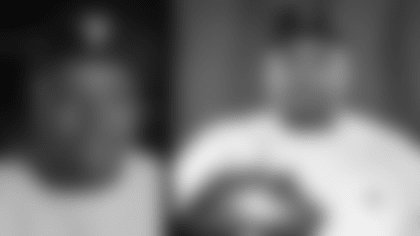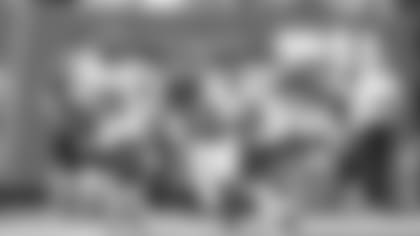Bengals tight ends coach James Casey and his prized free agent Hayden Hurst find themselves at the top of their profession on football's biggest stage.
But they have bonded as quickly as one of their 96 mile-per-hour heaters they could never cool in the unforgiving catacombs of baseball's low minor leagues.
"I didn't know where it was going. That's why I'm here, says Hurst, who knows exactly where he is now in the middle of Joe Burrow's sight lines.
"I had a good first year but couldn't control it very well," says Casey, who didn't try to switch to designated hitter.
Hurst did, but that's the only difference on their 60-foot, six-inch resumes that aren't eerily similar but welcomingly familiar.
"With our similar paths, he's a guy I can come talk to and pick his brain," Hurst says. "It's good for me to have a guy who mentality wise understands me. He can talk to me and coach me a certain way that maybe other guys haven't been able to get through to me."
Born a decade apart in Texas and Florida, respectively, Casey and Hurst were two strapping right-handers that could bring it. Both clocked 96 and worshipped at the altar of Nolan Ryan. Casey got drafted by the White Sox in the 2003 seventh round out of Azle High School. Hurst went in the 17th round to the Pirates in 2012 out of Jacksonville's The Bolles School.
"But third-round money," says Hurst and if there was any difference it was that Hurst was a bit more ballyhooed.
Yet the results were pretty much the same. They were both done with rookie league after three seasons because of control problems, but young enough to begin a college football career at tight end. Casey went to Rice University at age 23 and Hurst to the University of South Carolina at 22.
When the call came this time, it stuck. Casey went in the NFL's fifth round to the hometown Texans and stayed in the league for seven years. Hurst was a first-round pick of the Ravens and now he's on his third team in his fifth year on a one-year deal. But for a guy that walked on at South Carolina at age 22, he's used to crucial football seasons.
"It's crazy with so much of the similarities," Casey says. "There's a connection with guys who played minor-league baseball. It's hard to explain. Just the grind of being on buses all over the place. The (little) locker rooms. Being there in extended spring training. It's fun to talk. Right now, we're trying to install the offense, but we'll be able to tell a bunch of stories."
They can talk about how they have this in common, too.
"Baseball players are so much different than football players. Baseball players are weird. They're different," Hurst says. "Everyone always used to tell me I was a football player playing baseball. I didn't believe them until I finally made the switch. My personality, I think I'm more intense."
Casey had people telling him that, too. A quarterback in high school, they said he was a football player on the mound. During batting practice he would barge through the outfield to shag flies. He often thought if he had been a position player he might have had a better shot.
But it wasn't for not trying. After his stint in the minors, Casey gave independent ball a shot in 2006 for 34 more innings, but there was just no getting around 109 walks in 145 1/3 innings.
Casey's lack of control wasn't as spectacular as what happened in Hurst's well-documented struggles with the yips. Hurst could get on the mound for just 1/3 of an inning with Pittsburgh's affiliate in the Gulf Coast League in 2013, where he walked all five hitters with two wild pitches. From there it was one long bullpen session and intrasquad game. In 2014, he suggested to the front office a try at first base and designated hitter. He hit .245 in 53 at-bats before turning to football.
"I didn't love it," Hurst says. "The lack of success of pitching stole the joy for me. I was pretty much done. I had never been away from home, I was 18 and I wasn't making the best decisions on and off the field."
Hurst's battle with control led to deeper problems and his courageous struggle with alcohol, drugs and depression has become one of the country's most riveting success stories of the last decade. When he dined with Casey during free agency back in March and began to realize the bond, his phrase, "God works in mysterious ways," resonated again.
"It's kind of weird," Hurst says. "We sat down and talked when I first signed. We were telling war stories. 'This guy understands.' I'm meeting with him throughout the day, getting caught up in the playbook. This is a make-or-break year. I'm all in. I'll do whatever I can do."
One day this week after a voluntary practice they bumped into each other outside the cafeteria and they began comparing the motions they had in high school. Even pantomiming in a hallway, the 6-4, 245-pound Hurst looked downright nasty coming three-quarters. The 6-4, 215-pound Casey had a funky hesitation before coming over the top.
And they have this in common.
"I tried to do everything the coach was saying," Casey says. "I had different mechanics in high school. It was kind of unique, but it worked for me. They just started adjusting my mechanics and I was taking everything they said literally. 'Keep my shoulders square.' I should have stayed with what I was doing. You just can't change how I throw the ball."
Hurst went through a different kind hell. Fooling with his motion was the least of it. Once a coach screamed at him "What the bleep is wrong with you?" Catchers refused to work with him.
But Casey has so much admiration for Hurst, particularly for trying his hand with the bat. No extra base hits and two RBIs. But he crushed some balls, too.
"You know how hard that is?" Casey asks him. "To go up there and make those kinds of swings? I wish I had taken a chance doing that."
The stories are going to have to wait. They're here to make Hurst realize his potential as the 25th player taken in the 2018 draft. It's nice watershed moment for both. Casey has never coached a first-rounder and Hurst has never been on an offense like this. As valuable and as clutch as C.J. Uzomah was for Joe Burrow last season, the coaches can't wait to deploy Hurst's first-round speed in the middle of the field.
"He's tough, he's coachable. He's got a great attitude," Casey says. "My thing is sometimes guys run into bad luck. He goes to Baltimore with Mark Andrews and gets hurt early (with a stress fracture). Then after he has a big year in Atlanta, they draft (No. 4) Kyle Pitts. Sometimes it just comes down to an opportunity. I don't think he's been able to show what he can do. He's a great talent."
As for Hurst, we know how excited he is. He said this last week: "I think this staff finally understands what I'm capable of. "It's taken five years, unfortunately. I think God put me in Cincinnati for a reason. I'm just going to do my job, buckle down, learn this playbook, and just work my ass off. That's all I can do."
And he loves the division. There's even more baseball irony. The Pirates play in the city of the Steelers, whose arch-rivals live in Cincinnati and Baltimore.
"My allegiance is no longer to the black and gold," Hurst says. "The hatred in the AFC North is real. It's pretty cool to be a part of it."
So is sharing the job with fellow old power pitcher.
"I wouldn't want to have changed a thing," says Hurst of the long walk from the mound to Casey's room.







